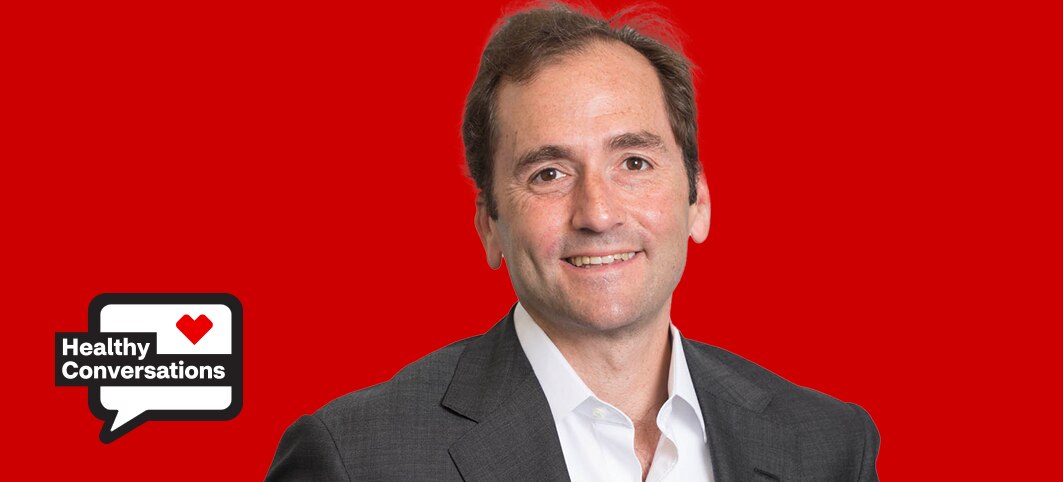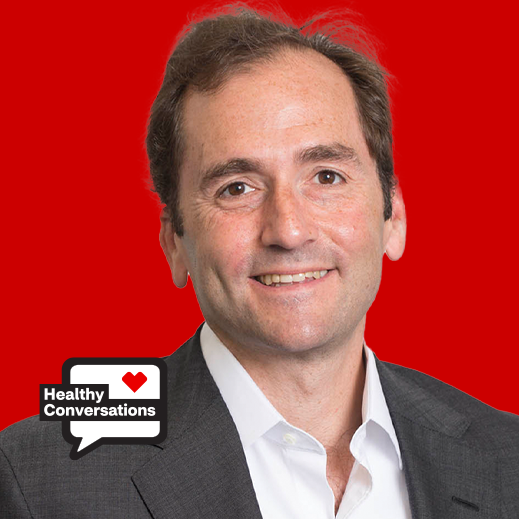CARA MCNULTY (00:02):
Welcome to Healthy Conversations. I'm Cara McNulty, President of Behavioral Health and Mental Wellbeing at CVS Health. Today we have a special edition of Healthy Conversations in recognition of Suicide Prevention Awareness Month. Last fall, our host, Dr. Daniel Kraft, interviewed Dr. Seth Feuerstein, psychiatrist faculty member at Yale and CEO of Oui Therapeutics. The two explored the issue of suicide in great detail.
(00:32):
Suicide continues to be an ongoing public health issue that has been exacerbated by the pandemic. According to the CDC, suicide rates increased 33% between 1999 and 2019. While we saw a very small decline in 2019 and 2020, this past February the CDC reported an increase in suicide. Unfortunately, suicide rates nearly returned to their 2018 peak. As doctors Kraft and Feuerstein discuss in the first episode, suicide is a complex health issue and people continue to believe in many common myths about it.
(01:11):
However, from a public health perspective, suicide is generally preventable. By using a systematic approach grounded in early detection, evidence-based interventions, postvention and community education, as we've done at CVS Health, we can work together to save and change lives. For instance, in late 2020, we initiated our strategy to reduce suicide attempts among Aetna members and to raise awareness of suicide prevention among our CVS colleagues and in our communities.
(01:46):
While we have seen a 16% decrease in suicide attempts among our commercially insured adult members compared to a 2019 baseline, we've also seen how important it is for everyone to be more vocal about their mental health and to be willing to talk about the importance of suicide prevention, especially among adolescents and older adults. These two populations are in need of additional support and targeted interventions. It is extremely valuable for businesses, leaders, doctors, hospitals, educators, parents, family members, friends and others to learn about the unique nature of suicide and know how to provide support when needed.
(02:30):
Dr. Kraft and Dr. Feuerstein go into great detail. Before we share their conversation, I want to highlight some other resources available to learn more and engage in suicide prevention. Mental Health First Aid and Talk Saves Lives trainings are really great resources to learn more about mental health and suicide and to learn strategies to help someone who may be in crisis.
(02:54):
The American Foundation for Suicide Prevention is a great place to learn about the facts of suicide. The Jed Foundation is also a great resource for youth suicide prevention, and the Trevor Project is a leader when it comes to LGBTQ+ mental health and suicide prevention. You can also visit cvshealth.com, where we have mental health guides for parents, educators, young adults, and coming out support guides for LGBTQ+ youth and young adults, podcasts and more.
(03:27):
Please keep in mind if you or someone you know needs immediate support, you can also dial 988 to speak with a counselor. The National 988 Suicide and Crisis Lifeline actually just celebrated its one-year anniversary and has answered nearly 5 million contacts, which is about 2 million more than the previous 12 months. This shows we can continue to offer hope to those in need while making a real difference. Now onto the conversation with Dr. Feuerstein.
DR. SETH FEUERSTEIN (04:00):
The only cause of death that's more common is accidents, actually.
DR. DANIEL KRAFT (04:05):
Welcome to Healthy Conversations. I'm Dr. Daniel Kraft, and today I'm in Healthy Conversations with Dr. Seth Feuerstein, the CEO of Oui Therapeutics. We've got a lot to talk about. So, for the first time on Healthy Conversations, we're going to have the same guest for a two-part podcast. Today we'll be talking about a topic that's been very much in the news and a bit exacerbated by the pandemic, suicide. Suicide kills more than 45,000 people in the US each year, a rate that's remained stubbornly high even with efforts like the New National 988 hotline. So Seth, why do you think we haven't been able to really move the needle on suicide more?
DR. SETH FEUERSTEIN (04:43):
It's one of the reasons I ended up spending most of my professional time on this issue. Suicide is a condition of the brain that's universal in societies around the world. So in some ways it's more like diseases that can cause sudden death like cardiac arrhythmias in some ways. And so I doubt we'll ever completely get rid of it, but we could certainly do better.
(05:03):
I think there are a variety of systemic issues as well as misconceptions and preconceptions about suicide that remain stubborn problems in terms of bending the curve and shifting the curve and reducing the number of attempts and deaths. I've been really fortunate to have some of the best training one can have to be on faculty at one of the best medical schools there is, and yet I had some significant misconceptions and preconceptions about suicide despite all of this and besides being trained as a psychiatrist that I'm really undoing and relearning over the last seven or eight years since I decided to focus on this area.
DR. DANIEL KRAFT (05:39):
Certainly it's one of the leading causes of death in younger folks. And you mentioned you had your own common misconceptions. What are the ones that you still see commonly across healthcare profession and maybe even in psychiatry specifically?
DR. SETH FEUERSTEIN (05:51):
I'm going to start with some of those statistics because they are really, really frightening and I don't think we talk about them a lot because we often feel we can't do a lot about them. So the CDC and other estimates indicate that approximately one and a half million people a year attempt suicide in the US and somewhere between 12 and 15 or 20 million, it's really not entirely known, think about suicide, have what's called suicidal ideation. The only cause of death that's more common is accidents, actually. So suicide is the number one medical cause of death for people in their teens and 20s. Suicide is the fourth leading cause of death for people in their 30s, 40s, and 50s.
(06:29):
The thing that I started to conclude as I reviewed the data was that the suicidal state of the brain is a lot like the arrhythmia state of the heart. It's a relatively spontaneous period where there's an elevated risk of sudden death. And if we think about attempts as potentially deadly events or cancer metastases, we can focus in on preventing those deadly events, which has proven to be a successful model in other diseases like cardiac and oncology diseases. Does that make sense, Daniel?
DR. DANIEL KRAFT (07:04):
Yeah, I think that's a good analogy. I think we've all known friends or even colleagues who may have been suicidal or even successfully concluded that we didn't have a clue of, didn't seem to be on that mental health trajectory where anything seemed to be wrong. And are there ways to find those early equivalent of the atrial fibrillation or EKG that can pick up folks at risk even when they don't outwardly seem to be?
DR. SETH FEUERSTEIN (07:25):
There are, and we're getting better at that, and one of the reasons we don't generally actively look is that if you speak to psychiatrists and other clinicians, they'll tell you they're not exactly sure what to do with the patients to reduce their risk once they identify them. If you went to your closest hospital and you said, how many stroke patients did you see in the emergency room this past year? Probably somebody in the hospital can say, we saw X number of stroke patients in the emergency room last month and last year. Same with heart attacks, same with arrhythmias.
(07:59):
If you said to them, how many suicidal patients did you see in the emergency room, they probably would not even know where to look. They're not thinking about this in the same way they think about other leading killers, even though it's actually a major cause of lost life years in the United States. And I think we have a long history in healthcare when we know we can do something, we actively seek out those patients. When we're not sure if we can do something, we don't.
(08:24):
The truth is most people who attempt and die by suicide do not have major depressive disorder. And you also mentioned heart disease. It's a really great analogy. Diseases like depression and bipolar, they're risk factors, but they're not directly causative. And if you look at the risk factors for things like cardiac arrhythmia, they're remarkably similar to the risk factors for suicide. The very best predictor of a cardiac arrhythmia is a previous cardiac arrhythmia, and the same as with suicide attempts. The very best predictor of a suicide attempt is a previous suicide attempt, and for every death there are about 30 attempts in the United States.
DR. DANIEL KRAFT (09:01):
Thanks to the stigma of mental health, an attempt may not follow someone in their records so that you can be proactive in on the outlook. Are there better ways to integrate that into our EMRs and workflow of all forms of clinicians so that you've had a heads-up that maybe even it was 10 years ago, someone had an attempt?
DR. SETH FEUERSTEIN (09:18):
Generally speaking, people were not screening for this, so the Joint Commission took it upon itself to start to push that forward. The Joint Commission, in fact about two years ago, first started encouraging and requiring hospitals to start to screen people for suicidality, and so we're starting somewhere as a system, we're getting better. There are outstanding researchers looking at all kinds of data sources to better predict what might lead to an attempt.
DR. DANIEL KRAFT (09:45):
Are there any sort of top elements that you'd recommend that we put on our radar when we're even talking to our friends and family, let alone our patients, to sort of see those early signs or even the acute signs that often are commonly missed?
DR. SETH FEUERSTEIN (09:58):
Suicide, in my experience, may make clinicians more uncomfortable than any other condition, and I think the first thing is related to stigma. A lot of clinicians and a lot of non-clinicians are uncomfortable talking about suicide. If we think about a suicidal state of the brain as an arrhythmia like state in the heart, hopefully it'll make it easier for clinicians to talk about it. I think people are nervous that if they identify suicidality, they're not sure what to do with the patient, who to send that patient to.
(10:28):
People get very nervous when they know a patient is suicidal because an attempt or a death feels like something we should have been able to predict and it feels like something that we might get sued for if it happens. The reality is asking from a legal perspective is better than not asking, and while it may be human nature to avoid areas where we're uncomfortable, it's an area we really should embrace.
DR. DANIEL KRAFT (10:52):
Are there any kind of equivalents to the screening EKG or cholesterol measure that could give us earlier insights into who's at risk?
DR. SETH FEUERSTEIN (11:02):
Absolutely. There's some researchers who've developed something called the Suicide Cognition Scale, which is doing a pretty good job at providing indicative looks at future risk for people who've been seen in psychiatric settings. There's a group at Harvard looking at a variety of digital biomarkers as well as electronic medical record data. There's no doubt that the kind of data that can be captured digitally will revolutionize our ability to be more contemporaneous with the periods of that risk and the ability to intervene with people when they are at risk. No question.
DR. DANIEL KRAFT (11:36):
We're now in this era of digital biomarkers. Voice is a biomarker that can pick up mental health or neurologic issues. Give us a little bit of a flavor of where things might get to be more specific.
DR. SETH FEUERSTEIN (11:45):
I've been doing digital psychiatry work for more than a decade, probably about 15 years now. It's interesting. I did a lot of genetics work before that. I believe that what genomics and proteomics were to disease categories like oncology, software will be to the brain. The brain is essentially an information acquisition processing and distribution center.
(12:08):
So if we can ping that information processing center, see how the brain and the body react to that ping, whether we're pinging it with software or applying something inside the body like a drug or from outside the body to inside, like transcranial magnetic stimulation, software is a tool that will allow us to gather tremendous amounts of useful data to understand what is working, what's not working, and what can work better.
DR. DANIEL KRAFT (12:33):
In terms of precision psychiatry, are there different subtypes of suicidality? If we can measure those, might we subset those patients or folks at risk of being suicidal into different prevention and intervention realms?
DR. SETH FEUERSTEIN (12:46):
It's a very insightful question and it's absolutely true. There are some people who are chronically suicidal ideators, meaning they think about suicide a lot and they have little or no risk of ever having an attempt. There are some people who rarely ever think about suicidality, but when they do think about suicide, the risk of an attempt is very high and there's an infinite number of gradations in between.
(13:09):
What they share in common is that at the moment when there's an attempt that might lead to death, there's an inability of the brain to function properly and to see another option. Broadly, though, they'll almost universally tell you they actually didn't want to die, but they just didn't see another option at the time. It really undermines a lot of what people normally say when they hear someone attempted or thought about suicide. Why did they choose to do that? The brain, as something that's a sort of logic driven machine, doesn't actually see something to get it past what's in front of it. It only sees the one choice. Does that make sense?
DR. DANIEL KRAFT (13:49):
Sure, so there are folks who have the underlying, let's say back pain or arrhythmia or mental health issue, others that we seem to be surprised that they had a suicide attempt or unfortunately a successful one.
DR. SETH FEUERSTEIN (14:01):
We need to think about suicidal ideation in the way we think about things like chronic back pain. I can have back pain all the time and have little or no risk of ever having a ruptured disc. Or I can rarely ever have back pain, but if I have it, I may have a ruptured disc almost immediately thereafter. It really depends on the situation.
(14:24):
We know that people who aren't sleeping well are at increased risk. We know that you don't process information as well and you're more impulsive when you're not sleeping. At the same time what you're texting to people, the types of language you use, what you hear in the tone of your voice, all of those data sources and many more are relevant to predicting risk.
DR. DANIEL KRAFT (14:44):
You've had a pretty amazing and varied background, undergrad at Cornell Medical and Law School from NYU. We won't hold your law degree against you. And you did your internship at residency at Yale where you're in the faculty of the School of Medicine, but what really drove you to work on the issue of suicide?
DR. SETH FEUERSTEIN (14:59):
Suicide had always befuddled me since I was a resident because we were asked to make judgements about patients, but there really wasn't a tremendous amount of data in that, and then even after we knew someone was at risk, there really wasn't clarity around what we could do to reduce that risk, and that's what I got focused on. One of the things that I get most excited about is working on tough problems. Reading a lot of the research that came across my desk on the topic pretty quickly made me realize that even though I had been on faculty at a leading university in the Department of Psychiatry for more than a decade, I misunderstood.
(15:33):
The second was I had had a pretty successful career leveraging software in healthcare and mental healthcare delivery and felt that some of the things that I had been fortunate to be successful in could be applied to suicide risk, and the third was that it was the most inefficient and most problematic area potentially in all of healthcare that one could make a big dent in. And so that was really attractive to me.
DR. DANIEL KRAFT (16:00):
I know you've done work with the military. There's definitely a pandemic of suicidality amongst service members, particularly those often served overseas in challenging environments. Maybe touch on the PTSD side and some of these new emerging therapies that go outside of traditional, let's say antidepressants and counseling.
DR. SETH FEUERSTEIN (16:17):
Generally speaking, medications for psychiatric conditions per se have not been shown to reduce risk of suicide, even though they can improve your depression, for instance. PTSD is a risk factor. It's essentially a stressor on the organ, a very clear stressor. Any organ in your body can give way at any time, whether it's your liver, your kidney. You twist your knee fast enough and strong enough on the football field, your ACL can snap, and I think that's really the model we need to think about when we think about the stressors that people put on their brain. That can be me or you statistically, Daniel. I don't actually know exactly how old you are, but I think we're both in that number four cause of death window. You and I are at a much higher risk of becoming suicidal than getting melanoma, but I don't think it even occurs to us to not put sunscreen on when we go to the beach. We do it because we think we're at risk and it can help us.
(17:16):
The brain is the same. If we have a condition like PTSD, or somewhere else in our life there's a stressor, we need to be realistic that it is the number four cause of death for us regardless of where we sit. We can't envision it entering that suicidal mode, but it can happen. And when it happens, it doesn't mean that we're weaker. It's what happens when the organ misfires. It's not your fault. We just need to provide the resources and the tools to reduce that risk and also to treat your PTSD.
DR. DANIEL KRAFT (17:44):
Yeah. I think that's an enlightening way to frame it. I met Zak Williams, the son of Robin Williams, who's quite active in the mental health space, and he used a term that I hadn't heard before, which is sort of practicing mental health hygiene, whether it's mindfulness and meditation or optimizing sleep or social connection. What are those ways that you can inoculate against bad mental health, but all the way to suicidality?
DR. SETH FEUERSTEIN (18:06):
I think we all know that if you take a solid week off from work, if you have that luxury, or stop doing the things that stress your brain, you feel a lot better at the end of the week. Oncology is a great example. If you've ever lived through a cancer diagnosis, it very much feels to the patient in many cases, like their options are narrowing. It's not that cancer patients want to die, but the outcomes that they face are very, very large. I think it was that 40% of patients who get diagnosed with cancer end up in bankruptcy due to the result of the costs of their cancer treatment.
(18:43):
So you're pulling yourself and your loved ones into bankruptcy with you. Think about the toll that that takes on the brain as an organ. What kind of options would I see? Now couple that with lack of sleep, the medications from the treatment, and all of a sudden you're loading up the brain with all kinds of trauma around which it needs to start to make decisions, and it really freezes up in the same way your laptop might freeze up and stop functioning.
DR. DANIEL KRAFT (19:12):
Healthcare issues are the leading cause in bankruptcy in general in the US. Is there a difference in folks in the UK with NHS where they have underlying insurance?
DR. SETH FEUERSTEIN (19:20):
Suicide rates are higher in the US across many of these age groups than they are in the United Kingdom. We're seeing a new wave of companies focusing more on serious mental illness, diseases like schizophrenia and bipolar, and working with health insurers around that. When it comes to suicide, we had this phenomenon in the psychiatric system broadly, not just in digital health, where suicide patients are turned away. Nobody wants them. I think there's two reasons they generally are not wanted as new patients. One is the perceived liability risk and the other is the feeling that they don't have good treatment options for them.
(19:56):
It is the only leading killer without a prescription product available. So as a clinician who's a prescriber, I don't have an option. That's one problem. The other is the interventions that have been proven to work. They're really like a subspecialty, but the system isn't structured around subspecialties within psychiatry. So for instance, in cardiology, if I have an arrhythmia, I might be sent to an electrophysiologist. Suicide is similar. The interventions are quite different than other interventions in order to work to reduce suicide attempt risk.
DR. DANIEL KRAFT (20:27):
That's an interesting point. There certainly aren't suicidologists. If you were to wave your magic wand and you had more folks trained in this area, what are the most effective tools that they could use that take folks at risk who've had attempts, and to have them fully recover?
DR. SETH FEUERSTEIN (20:43):
In terms of reducing attempts, the first therapy to get wide recognition was called dialectic behavioral therapy or DBT. The challenge with DBT is it's extraordinarily costly and intensive. Patients typically go for at least several weeks and often several months of around the clock care with access to their clinicians at night via text, and that showed modest reductions in attempts. The second category was a modified version of cognitive behavioral therapy, which is about three months in length. That's the one I got most interested in. It actually separated attempts from ideation. That was one important breakthrough. And the second is it focused on giving the patient control.
(21:26):
So as clinicians, we were often scared to say, "Look, you can manage this yourself." That feels uncomfortable for clinicians, but what these researchers showed that they can reduce suicide attempts by 60% or more by going through this very specific, very specialized therapy. If I could wave my magic wand, we'd have an unlimited number of clinicians doing this. The problem with that is twofold. I don't have a magic wand. And the second is the work is intensive.
DR. DANIEL KRAFT (21:56):
As we're now three years into the COVID pandemic, we certainly mentioned earlier stressors that can build up, we certainly see some high profile cases of physicians taking their own lives. Any learnings from that?
DR. SETH FEUERSTEIN (22:08):
I'm going to say something very simple. Figure out, even if you need to ask people you know when and what are the things that cause you to be more irritable, to sleep less well. Pull back from those things. And then number two, turn off your cell phone. Every day, a couple hours before you go to bed, as hard as it sounds, leave your phone in another room when you go to bed. The digital bombardment of the brain, from all the data I've seen, is definitely an ongoing stressor and everything will be fine 12 hours from now if you put your phone in airplane mode. I found for myself that that was an incredibly powerful thing and just detach as often as you can.
DR. DANIEL KRAFT (22:56):
So doom scrolling Twitter before I go to bed is not a good idea. I need to act on that myself.
DR. SETH FEUERSTEIN (23:02):
That's a great interpretation of what I said.
DR. DANIEL KRAFT (23:04):
Well, thank you so much, Seth Feuerstein, for joining us on this issue of Health Conversations. A lot of insights and a lot of things to think about and hopefully take into our day-to-day life and practice, and we're happy to have you on our next segment. We'll be talking more about some of the emerging digital tools and digital therapeutics that can help prevent suicide, so hopefully if you are listening, will join us then, and thanks for joining us on this issue of Healthy Conversations.
CARA MCNULTY (23:30):
Please join us for episode two with Dr. Feuerstein, where he talks about the innovative prescription digital therapeutics that his company has developed to help manage patients with suicidal ideation. The episode will launch on September 20th.




